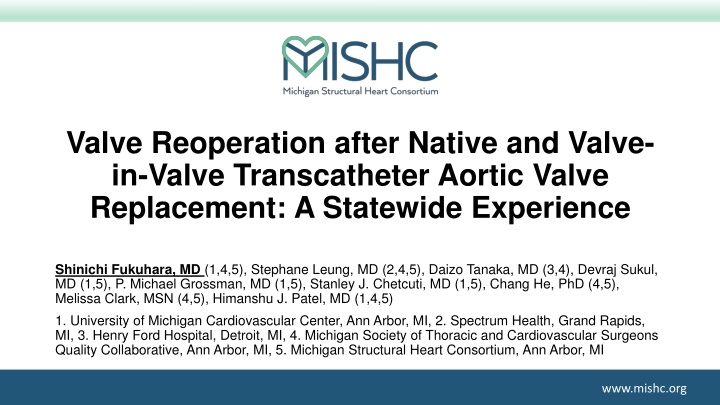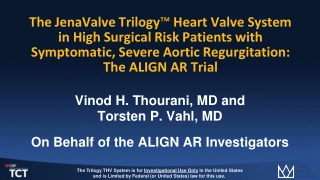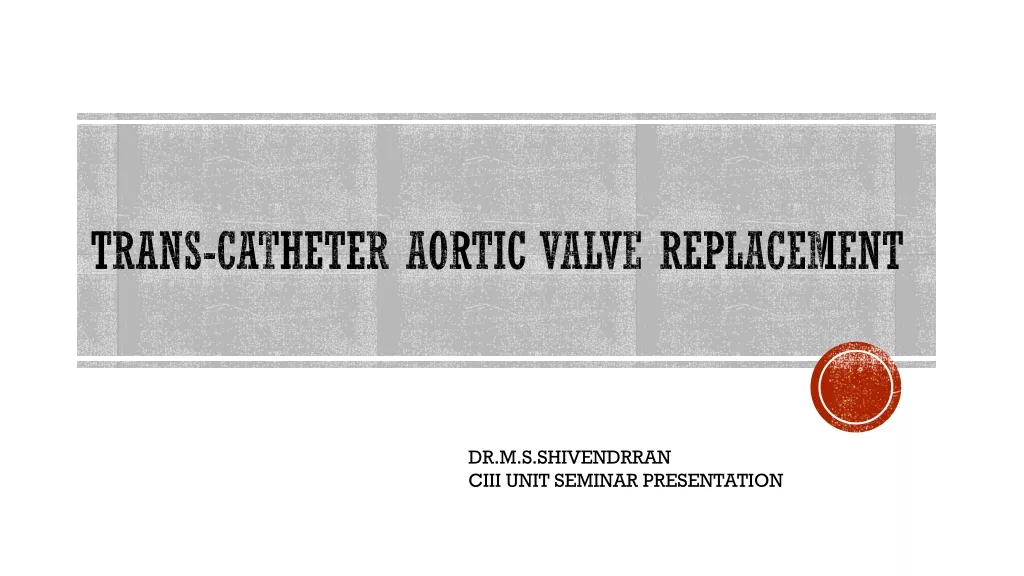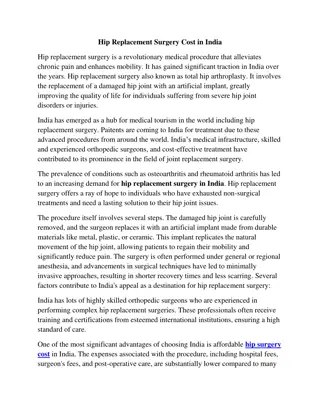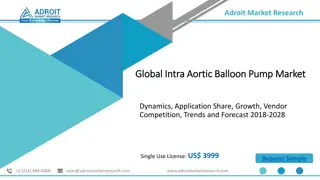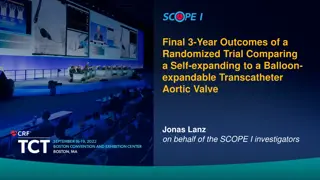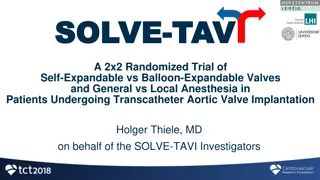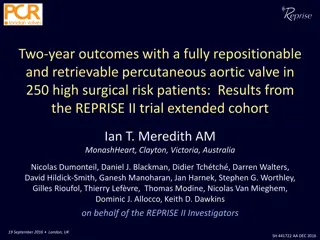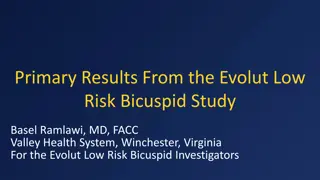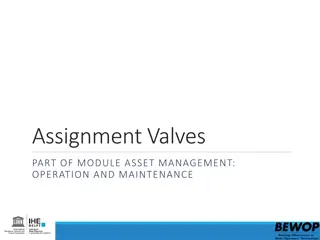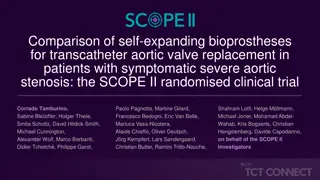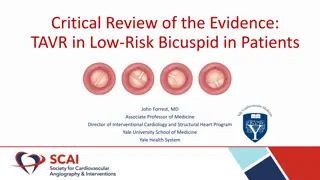Reoperation Trends in Aortic Valve Replacement
Investigating reoperations after native and valve-in-valve transcatheter aortic valve replacement (TAVR), this study analyzes characteristics and implications, noting a higher frequency in valve-in-valve cases. Data on demographics and trends in reoperation rates shed light on the outcomes of these procedures.
Download Presentation

Please find below an Image/Link to download the presentation.
The content on the website is provided AS IS for your information and personal use only. It may not be sold, licensed, or shared on other websites without obtaining consent from the author.If you encounter any issues during the download, it is possible that the publisher has removed the file from their server.
You are allowed to download the files provided on this website for personal or commercial use, subject to the condition that they are used lawfully. All files are the property of their respective owners.
The content on the website is provided AS IS for your information and personal use only. It may not be sold, licensed, or shared on other websites without obtaining consent from the author.
E N D
Presentation Transcript
Valve Reoperation after Native and Valve- in-Valve Transcatheter Aortic Valve Replacement: A Statewide Experience Shinichi Fukuhara, MD (1,4,5), Stephane Leung, MD (2,4,5), Daizo Tanaka, MD (3,4), Devraj Sukul, MD (1,5), P. Michael Grossman, MD (1,5), Stanley J. Chetcuti, MD (1,5), Chang He, PhD (4,5), Melissa Clark, MSN (4,5), Himanshu J. Patel, MD (1,4,5) 1. University of Michigan Cardiovascular Center, Ann Arbor, MI, 2. Spectrum Health, Grand Rapids, MI, 3. Henry Ford Hospital, Detroit, MI, 4. Michigan Society of Thoracic and Cardiovascular Surgeons Quality Collaborative, Ann Arbor, MI, 5. Michigan Structural Heart Consortium, Ann Arbor, MI www.mishc.org
Disclosures Shinichi Fukuhara: Consultant for Terumo Aortic, Medtronic Inc. Steering committee for Artivion PERSEVERE trial Himanshu Patel: Consultant for Medtronic Inc. Stanley Chetcuti: Consultant for Medtronic Inc, Jena, Biotrace. Others have nothing to disclose. www.mishc.org
Introduction The use of bioprostheses during SAVR has increased substantially [1], expecting future valve-in-valve TAVR (VIV-TAVR). Bioprosthetic SAVR Mechanical SAVR There are scant data regarding reoperations following VIV-TAVR. 1. Tam DY, et al. Surgical valve selection in the era of transcatheter aortic valve replacement in the Society of Thoracic Surgeons Database. J Thorac Cardiovasc Surg. 2020;159:416-427. www.mishc.org
Objectives We sought to investigate the characteristics and implications of patients undergoing aortic valve reoperations after native TAVR and VIV-TAVR. www.mishc.org
Cohort Index TAVR data captured in patients with reoperation www.mishc.org
Trend www.mishc.org
Frequency of Reoperation Native TAVR VS VIV-TAVR 1/3 of reoperations were VIV- TAVR cases Frequency: 7 times higher in VIV-TAVR No difference in the incidence between stented vs stentless VIV-TAVR www.mishc.org
Demographics TAVR-in-SAVR Native TAVR Characteristic P-value (n=19) (n=41) Age (years) 73.0 (65.5 77.5) 72.0 (68.0 76.0) 0.66 Female 6 (32) 13 (32) 0.99 Dialysis 0 7 (17) 0.086 Permanent pacemaker 0 21 (51) < 0.001 Prior sternotomy 19 (100) 17 (42) < 0.001 NYHA class III/IV 13 (68) 29 (71) 0.86 STS-PROM (%) 5.8 (2.8 9.2) 9.9 (5.1 15.6) 0.084 www.mishc.org
Previous SAVR Valve Type Previous surgical bioprosthesis TAVR-in-SAVR (n=19) Stented bioprosthesis 11 (58) Labeled valve size (mm) 24.0 (22.5 27.5) Stentless bioprosthesis 8 (42) Labeled valve size (mm) 27.0 (25.5 28.5) www.mishc.org
Index TAVR TAVR-in-SAVR Native TAVR Characteristic P-value (n=19) (n=41) Time to reoperation (Years) 2.0 (0.5 4.0) 0.8 (0.3 2.4) 0.25 Index TAVR device type 0.014 Balloon-expandable 3 (16) 20 (49) Self-expandable 16 (84) 21 (51) Valve size (mm) 29 (23 29) 29 (26 34) 0.11 www.mishc.org
Primary Indication for Reoperation TAVR-in-SAVR Native TAVR Indication for Reoperation P-value (n=19) (n=41) AS 8 (42) 11 (27) 0.24 AI/PVL 15 (79) 18 (44) 0.013 Primary aortic aneurysm 2 (11) 0 0.097 Endocarditis 0 10 (24) 0.023 Hemolysis 0 1 (2) 1.00 Structural issues caused by TAVR valve 4 (21) 7 (17) 0.73 Mitral impingement 2 (50) 4 (57) 1.00 Coronary obstruction due to late migration 2 (50) 0 0.11 Secondary aortic dissection/aneurysm 0 2 (29) 0.49 VSD 0 1 (14) 1.00 www.mishc.org
Operative Data TAVR-in-SAVR Native TAVR p-value (n=19) (n=41) 193 (126 280) 155 (102 237) Cardiopulmonary bypass time (minutes) 0.55 184 (115 235) 142 (86 182) Cross-clamp time (minutes) 0.33 Concurrent procedures 2 (11) 2 (5) Annulus/aortic root enlargement 0.63 4 (21) 17 (42) Mitral repair/replacement 0.12 1 (5) 8 (26) CABG 0.13 2 (11) 6 (15) Tricuspid repair/replacement 0.66 9 (47) 9 (22) Aortic repair 0.046 7 (37) 7 (17) Aortic root repair 0.092 5 (26) 4 (10) Ascending aortic repair 0.13 1 (5) 2 (5) Aortic arch repair 1.00 0 1 (2) VSD repair 1.00 www.mishc.org
Aortic Repair Reasons High aortic repair rate in VIV- TAVR group driven by previous aortic root surgery TAVR explant trauma-related aortic repair was rare in patients with previous SAVR www.mishc.org
Postoperative Outcomes TAVR-in-SAVR Native TAVR p-value (n=19) (n=41) 2 (11) 7 (17) 30-day mortality 0.71 1.9 1.7 O/E ratio 0.88 0 2 (5) Stroke 1.00 6 (32) 12 (29) Prolonged mechanical ventilation 1.00 2 (11) 5 (15) Renal failure requiring new dialysis 1.00 3 (16) 1 (5) Permanent pacemaker 0.34 2 (11) 2 (5) Chest exploration for bleeding 0.59 Discharge location 0.31 12 (71) 19 (56) Home 5 (29) 15 (44) Extended care/rehabilitation facility www.mishc.org
Summary Approximately one third of reoperations were VIV-TAVR cases, which demonstrated exceedingly higher rate of reoperation compared with native TAVR. This fact challenges the worldwide trend of favoring bioprosthetic SAVR and presumptive future TAVR-in-SAVR concept. The frequent aortic repair during TAVR-explant in VIV-TAVR group appears mostly unrelated to TAVR explant trauma. www.mishc.org
